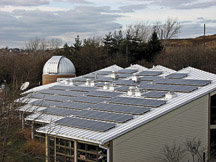Several Secaucus buildings have been chosen as sites for solar panels as part of a regional solar energy plan that could mean cheaper electricity for local residents.
Secaucus High School, Secaucus Middle School, two municipal parking lots, and two senior citizen buildings – the Elms and Kroll Heights – are among the locations identified by the New Jersey Meadowlands Commission (NJMC) as suitable for solar panels.
Now that sites for panels have been chosen, the next step is to figure out how energy companies and municipalities like Secaucus might develop “power purchase agreements.” The agreements would lay out the terms by which vendors would install the panels at the approved sites and sell energy back to the municipality. The next stage would be to find those vendors with an interest in renewable energy and have them install the panels.
By law New Jersey must generate 4,335 megawatts of state-based solar energy by 2026.
________
The municipality and taxpayers would benefit as well. Since renewable energy is cheaper than traditional energy sources, the town and school district would have reduced energy costs, thus saving taxpayer dollars. Assuming the municipality locked in a long-term contract with the vendor, the town could also benefit from having stable and predictable energy costs.
Other Meadowlands District towns are also participating in the program, including Little Ferry, Carlstadt, Moonachie, Rutherford, South Hackensack, and Teterboro.
Two-year location survey completed
As a part of its Municipal Solar Assistance Program, the NJMC has spent nearly two years evaluating rooftops throughout the Meadowlands District to see which ones might be best used for renewable energy. The NJMC, a state agency, underwrote all costs associated with this analysis.
Agency officials said they tried to undertake this plan ahead of upcoming state mandates. Under New Jersey’s Energy Master Plan, 30 percent of the state’s electricity must come from sustainable energy sources, such as sun or wind, by 2020. And by law, New Jersey must generate 4,335 megawatts of state-based solar energy by 2026.
“The NJMC’s Municipal Solar Assistance Program can help Meadowlands towns reap the benefits of using clean, low-cost solar power without having to spend taxpayer dollars,” said NJMC Executive Director Robert Ceberio. “The program is an excellent example of how the commission strives to use its resources to help reduce local government costs and improve residents’ quality of life.”
Next steps
With the first phase of the Municipal Solar Assistance Program – the selection of locations – now completed, the NJMC is moving into the next phase of the program.
The agency is already exploring ways to set up power purchase agreements with potential vendors.
Although in its initial phase the state agency worked with only a handful of municipalities, it has now expanded the program to all 14 of the state-designated Meadowlands District towns. The NJMC believes the region will benefit most by having a larger-scale program than what was initially planned. The program also will now include solar panels at ground level, in addition to ones on rooftops.
E-mail E. Assata Wright at awright@hudsonreporter.com.
